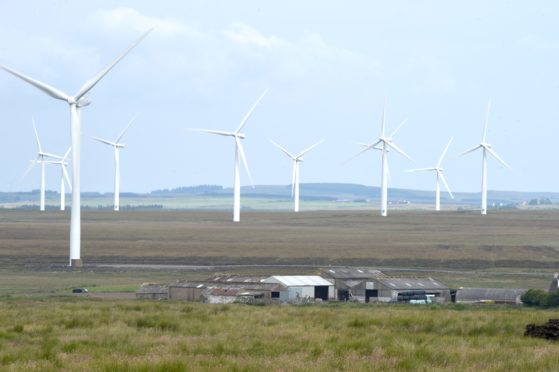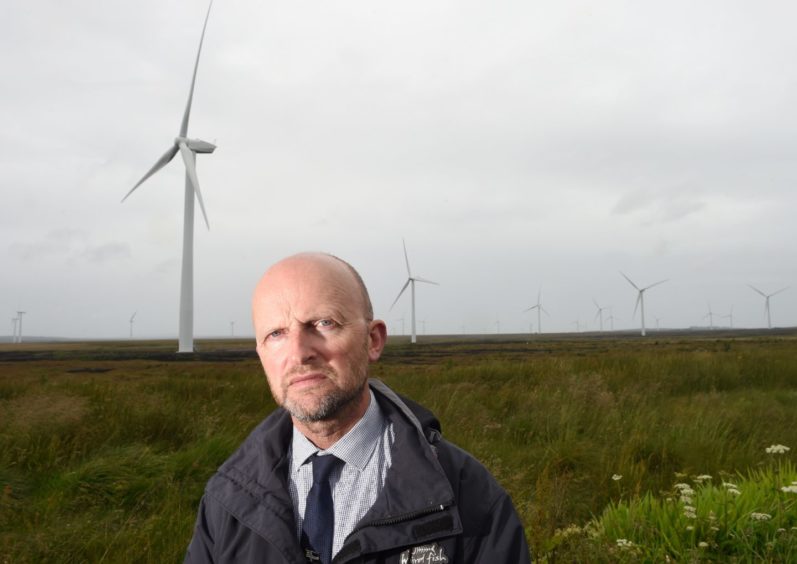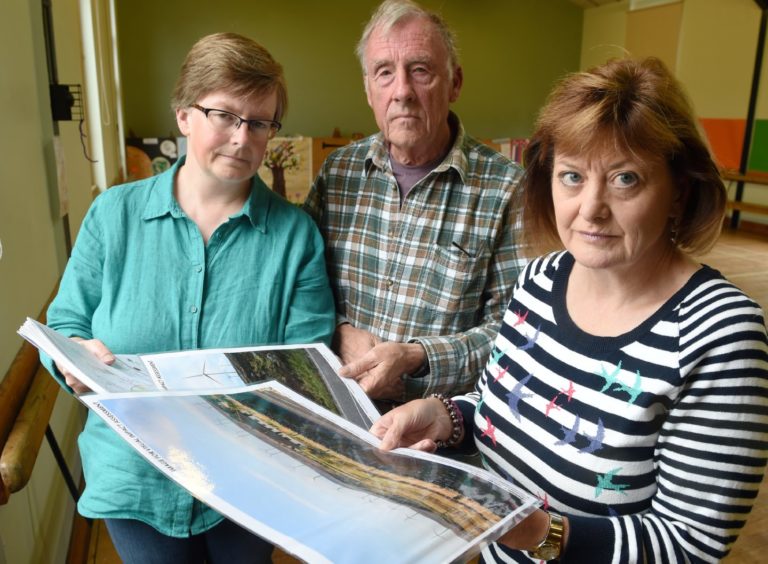Angry Caithness residents affected by the approval of a 21 turbine wind farm have vowed to fight on to protect their landscape and everything it means to them.
Reay Area Windfarm Opposition Group (Rawog) say the fight to stop their village being encircled by a ‘ring of steel’ has caused them untold stress over the past six years.
They say they are weary and disillusioned, but for the sake of their unique heritage, landscape and wildlife, they will fight on to stop more turbines coming their way.
The small north coast township already has the Baillie windfarm on its doorstep – boasting 21 turbines, each 360ft.
There are also the Forss 1 and 2 farms, adding an additional six 260ft towers, while each site has associated pylons and substations that extend their visual impact.
Soon Reay will look out on a further 21 turbines – stretching 450ft into the sky from ground to blade tip – less than a mile away on the Limekiln estate, despite hundreds of objections.
Highland Council initially refused planning permission for Limekiln but after a public local inquiry, developer Infinergy won its case at Scottish Government level.
Local councillor Matthew Reiss says the Limekiln approval process makes a mockery of localism and democracy.
He said: “I’ve gone through the Scottish reporter’s report and there is literally no mention of the fact that hundreds of local people said no to this wind farm.
“There is one tiny paragraph which says the Scottish Government needs to carry out research to assess the impact of wind farms in places like Caithness.
“I find it extraordinarily complacent that they say this research needs to be done. It should have been done already.
Rawog member Heather Thompson said that while the community judged it a battle worth fighting, opposition to the Limekiln scheme had proved expensive.
“We raised money to fight Limekiln and we won, but when the developers resubmitted the same application we had to start from the beginning and raise money again.
“For a small community that was extremely hard.”
Rawog eventually raised more than £15,000 to fight the proposals, money they say they would rather have spent on local groups and charities.
They liken their plight to a David and Goliath struggle against multinational companies with very deep pockets and the odds heavily weighted against them by government policy.
Rawog member and Caithness West community councillor Jillian Bundy said: “The reporters acknowledged that there will be a huge impact on the area visually but it’s almost as if it doesn’t matter, because there’s not many people.
“They argue that because we have Dounreay the landscape is already industrialised, but Dounreay is relatively well contained.
“It is not at a height. You can’t see it from all around and, importantly, it doesn’t move like turbines do.
“Caithness is becoming a wind farm landscape purely because the population is relatively low, and it’s windy.”
Resident naturalist and ornithologist Eric Maughan added: “These turbines are 20ft taller than the London Eye, which is a big structure but contained in a city with lots of other big structures.
“They’re going to put 21 London Eyes in this landscape.
“They’ll be in your face the whole time. You will be able to hear them whirring.
“It makes a mockery of the Scottish Government’s designation of this as wild land.”
The lack of jobs after the construction stage – likely to be one maintenance post per 18 turbines – and Limekiln’s impact on tourism are also on Reay residents’ minds.
Mrs Thompson said: “With Dounreay being decommissioned there will be fewer and fewer jobs, so the main driver of jobs will be tourism. This is going to take tourism away.”
With Caithness facing year-on-year depopulation, residents fear the turbines might even push some families to leave.
Mrs Bundy said: “It’s difficult at this point to know whether people will stay once they are constructed. We will certainly think about it.
“We feel like victims of Scottish Government policy on renewables.
“We’re supposed to live in a democracy, but while every organisation or public body that was involved as a consultee objected to this, they have all been completely ignored.”
Mrs Bundy also dismissed the potentially significant community benefits offered by developers – Infinergy have suggested they could be as much as £8 million – as ‘bribes.’
She said: “These are what we would call community bribes. Yes it is money for local groups, for village halls, small community grants for things, but it is a bribe.”
Significant benefits to the community
Infinergy chief executive Esbjorn Wilmar believes the firm has selected the perfect place for its latest project.
He said: “The Limekiln Wind Farm site is excellent for wind development. It has a very good wind resource and meets all environmental and technical requirements.
“The project will make an important contribution towards Scotland’s renewable energy targets.”
And Mr Wilmar said the wind farm will also offer significant benefits to the community during its lifespan.
“Limekiln Wind Farm comes with a community benefit fund of £5,000 per MW of installed capacity,” he said.
“That equates to at least £315,000 per year or nearly £8 million over the lifetime of the development (based on 3 MW turbines).
“In addition, up to 10% of the project will be made available to the local community as a shared ownership opportunity, giving the potential to increase the economic value of the wind farm across Caithness.”
A Scottish Government spokeswoman, meanwhile, reiterated its support of Scotland’s growing wind energy industry.
She said: “With public backing for wind energy at a record high across Scotland and amid a global climate emergency that requires decarbonisation of our economy, we strongly support the development of renewables, while providing appropriate protections for our landscapes, natural heritage and local communities.
“The Scottish Government has measures in place to ensure all relevant factors, such as any environment impact, health impact or impact on tourism, are all considered throughout the planning process for wind farms, before any decisions are made.”
All at the expense of the public purse
Castletown resident Brenda Herrick originally thought wind energy “sounded wonderful”.
But for the past 15 years she has been a member of the Caithness Windfarm Information Forum out of concern for the toll she believes the industry is taking on Scotland’s countryside.
Mrs Herrick, who is approaching 80, says wind farms are ruining the county in countless ways, making huge money for mainly foreign multinationals – all at the expense of the public purse.
She said: “The more you learn about it, you more you realise how destructive and crazy it is.
“They talk about wind energy saving carbon emissions, but quite often they don’t take into account the transport involved as most are not made here.
“They don’t consider the materials, with damage being done in China as they mine for for neodymium.
“The blades are not recyclable, so they’re piling up in all sort of places, and the turbine bases are massive, requiring hundreds of tonnes of concrete, which is an extremely destructive material.
“Then there’s the access roads being cut across the country side, causing permanent damage, and the converter stations and huge support sites they have built all over the place.
“Pylons have sprung up everywhere.
“Caithness is known for its wide views and big skies, but it is all being destroyed. People with influence clearly don’t live near them.
“Developers know how much money that stand to make. Almost without exception they are foreign companies, so it’s not money that’s staying in Scotland.
“It’s money that’s being paid through our bills.
“And more than half a billion pounds of public money has been paid out in the form of constraints payments, to switch them off if it’s too windy or if they’re generating too much power.”
Look out for our forthcoming podcast featuring the Limekiln objectors expanding on their sense of loss and betrayal


